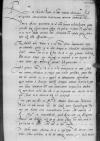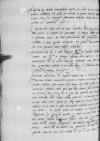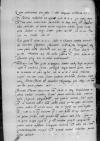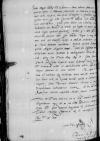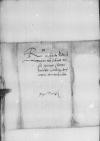Reddidit mihi ⌊frater⌋ Dominationis Vestrae Reverendissimae ⌊⌋ plenas humanissimae erga me voluntatis. Quibus quod me adeo benigne ac liberaliter salutandum duxit, summas pro eo, ac debeo, Reverendissimae Dominationi Vestrae ago gratias habeboque, dum vivam, semper, quae obsequendo ac serviendo a non ingrato homine haberi, agi referrique possunt diligentissimae.
Ad priores ⌊⌋ quod Reverendissimae Dominationi Vestrae nihil rescripserim, in cau<s>a fuit mea nimium festinata ac fugae paene similis profectio, quam tum, cum hic servitor Reverendissimae Dominationis Vestrae ageret in submontanum, adornabam, aegre tandem a principe tantilli temporis commeatu impetrato, quo mea bona salutassem et rem familiarem inspexissem tantum. Quam ob rem nihil tum sibi a me responsum esse obsecro, ne iniqui ferat, neve aliorsum atque est, accipiat.
Certe, quas cum ⌊⌋ ad illustrissimum dominum ⌊Ottonem Henriccum(!)⌋ palatinum ⌊Rheni⌋ etc. mihi miserat litteras, eas haud mora ⌊Nurenbergam⌋ factori meo, homini certo, transmittendas curavi cum mandato ad illius illustrissimum dominum transmittendi. Quod illum recte atque diligenter fecisse non dubito idque ab eo primis quibusque litteris eius mihi significatum iri spero, litteras autem in dies exspecto.
De rebus novis plurimas Reverendissimae Dominationi Vestrae ago gratias, sed minime mirum videri debere arbitror in his tot tantisque universi paene orbis turbis ⌊Angliam⌋ quoque minime tranquillam agere, nisi forte hoc eius malu[m] gravius putandum est, quod ab externa vi quieta intestino ma[lo] aestuat, adeoque eius tyrannide potissimum turbetur, cuius imperio quietam esse conveniret etc.
Nobiscum hic plane nihil est novi. Sacratissimi ⌊principes⌋, Dei gratia, recte valent ac valeant diu, precamur.
Sacra ⌊regia maiestas⌋ profe[ctum] ad ⌊conventum⌋ parat, nos item particularibus istis conventionibus in districtibus de more agendis accingimur. Dii quidem bene vertant, sed nescio, quomodo omnia bullire videntur.
Advenerunt huc ad sacram ⌊maiestatem regiam⌋ illustrissimi domini ⌊Ioachimi⌋ electori[s] oratores, suae illustrissimae dominationis ⌊coniugem⌋ filiam felici partu enixam ess[e] annuntiantes et ad sacras baptismi ceremonias ⌊suam maiestatem⌋ invi[tan]tes. Quam ob rem mittitur a ⌊sua maiestate⌋ illuc dominus ⌊Stanislaus Lasski⌋, castellanus Przemetensis etc.
Audivimus nudius tertius et legationem Tartaricam a ⌊Satkyrei⌋ Tauricano caesa[re] missam nuntiantem superasse se tandem adversarium suum, Asslam Sotthan, quem opera Beke murza cum mille equitibus ab ⌊h[orda] Kosanska⌋ submissis, dolo, quod apud illos honoris loco ducitur o..., ut posteaquam hunc aliosque omnes, a quibus sibi metuendum erat, sustuler... hanc victoriam ⌊maiestas regia⌋ secum gauderet declararetque, num a[mi]citiam colere velit, quam ipse longe, quam alii fecerint, meliore culturus sit in omni re, quae iureiurando constituta inter se fuerit idque factu sibi esse facile, nemine iam exstante, nec adversario, nec regulorum, quos czarziki vocant, qui suopte impetu vel inviti in ...tore praeter foedera incursiones facere erant soliti, quibus omnibus suam ditionem prorsus purgaverit, non amplius uno relicto, qui su[us] filius, haec se sancte observaturum esse, manentibus tamen donis sive [pi]gnoribus amicitiae, quae aliis tributa sunt, nec sunt adeo magni pr[aetii]. . Quam condicionem non puto
sacram ⌊maiestatem regiam⌋ reiecturam esse.
De ⌊palatino Valachiae⌋ non ignorat, credo, Reverendissima Dominatio Vestra. Caesi captique nuper sunt non pauci, incursiones facientibus ac longe lateque nostris populantibus feliciter ad pacem prorsus respicere videtur, quam etiam opera oratoris serenissimi regis ⌊Ioannis⌋ petere insistit, sed ea nec ⌊principi⌋, nec ⌊senatui⌋ cordi est.
Non ignota est etiam Reverendissimae Dominationi Vestrae clades in ⌊Sclavonia⌋ accepta,[1] deserentibus exercitum capitaneis ⌊Cancianero⌋, ⌊Schlick⌋ et ⌊Ungnad⌋, atque etiam paulo antea ⌊Morelaslo⌋ cum 300 equis ad ⌊Turcas⌋ transfugiente. Tormenta 43 illo praelio amissa sunt, porro plurimi ac clarissimi quique viri in eodem occubuerunt.
Felicius sunt res gestae in ⌊Ungaria⌋, tametsi eiusdem regis auspiciis capta sunt compluria castra, profligati magno numero hostes, nunc in ⌊Wronowo⌋ de pace agitur, inde enim ad me dominus ⌊Lasski⌋ palatinus scripsit esse iam secum ⌊caesaris⌋ oratorem ⌊archiepiscopum Lundensem⌋, exspectarique ⌊Petrum Perenni⌋ et ⌊monachum thesaurarium⌋, qui{s} regis sui nomine cum illis pacem facturi sint.
Proxima ⌊Thurcarum⌋ expeditione omnis classis in ⌊Regnum Neapolitanum⌋ impetum tenebat, occupatisque aliquot parum celebribus locis, conversis velis, ⌊Corcyram⌋ navigatum est. ⌊Qua⌋ graviter vastata, haud capta tamen, ad duodecim millia hominum, partim occisis, partim captis, obsidionem solvere coactus est, accepto nuntio, suos a ⌊Zophi⌋ non profligatos tantum (sicuti ex eis litteris didicimus, quas sacra ⌊maiestas reginalis⌋ et ego habuimus), sed plane deletos esse, capto insuper et maiore natu filio. Cuius rei ita gestae magna signa sunt, quod et tentatam ⌊Corcyrae⌋ oppugnationem, praeter morem infectam, relinquens discessit et recta omnem classem ⌊Constantinopolim⌋ recepit et ⌊Venetis⌋ minime petentibus pacem ultro obtulit.
Inter ⌊regem Galliae⌋ et ⌊Inferiorem Germaniam⌋ indutias factas esse c[aesarem] graviter ferre dominus ⌊Fabianus Dameraw⌋ ex ⌊Manshon⌋ in ⌊Hispa[nia]⌋ nuper mihi scripsit, hoc etiam adiungens dominum ⌊Cornelium Scepp[erum]⌋ agitare nescio quid inter caesarem et Gallum, unde nonnulla [se] spes ostendatur, quam plane tollere ista videntur, quod invitantibus eum ⌊pontifice⌋ ac ⌊Venetis⌋ per legatos ad pacem ape[rte] eorum ligam spreverit abieceritque. Deinde, quod sacra ⌊maiestas reginalis⌋ [et ego] acceperimus proxime litteras, quibus scribitur regem, si umquam ant[e], nunc certe cum maximis copiis in ⌊Italiam⌋ contendere, quae ad 60000 hominum censeantur. Quarum copiarum antegwa[rdiam](!) quidem magnus magister teneat, ipsum vero legitimum exer[citum] delphinus ducat, postremo in retrogwardia(!) rex ipse ...tat, adeoque iam ⌊Turini⌋ magnus magister sit. Contra ⌊marchi[o]... Guasto⌋, per castra dispositis copiis, hybernat litterasque per ⌊It[aliam]⌋ et ⌊Germaniam⌋ mittat, ut contraherentur milites, quod an s[uo] tempori futurum sit, Deus viderit. Regem certe [in]terea omnia maturare atque, trifariam diviso exercitu, minime uno loco haerere velle, sed unam exercitus partem in ⌊Lombardia⌋ r[e]linquere, aliam ⌊Florentiae⌋ admovere, tertiam ad ⌊Regnum Neapolitanum⌋ ducturum esse dicitur. Ad haec autem omni[a] ⌊pontificem⌋ accensum cupiditate obtinendi ⌊Camerini⌋ dissimulaturu[m].
His me et mea servitia Reverendissimae Dominationi Vestrae commendo, quam pos[sum], diligentissime rogoque, uti me sua solita benevolentia prosequi p.... Quam opto quam maxime longaevam et fortunatissima[m] valere.
